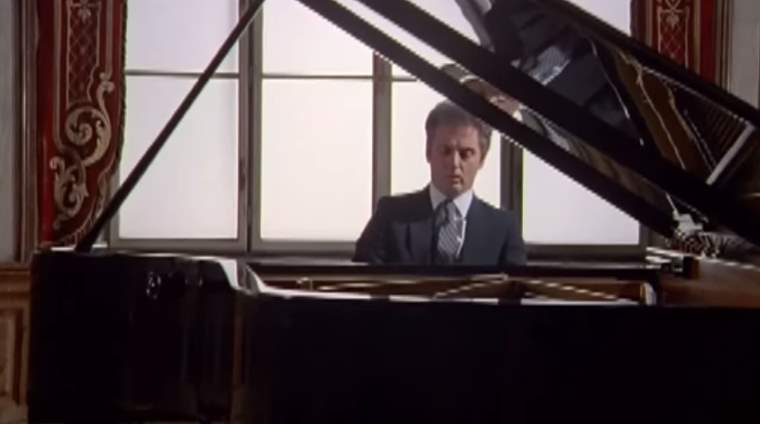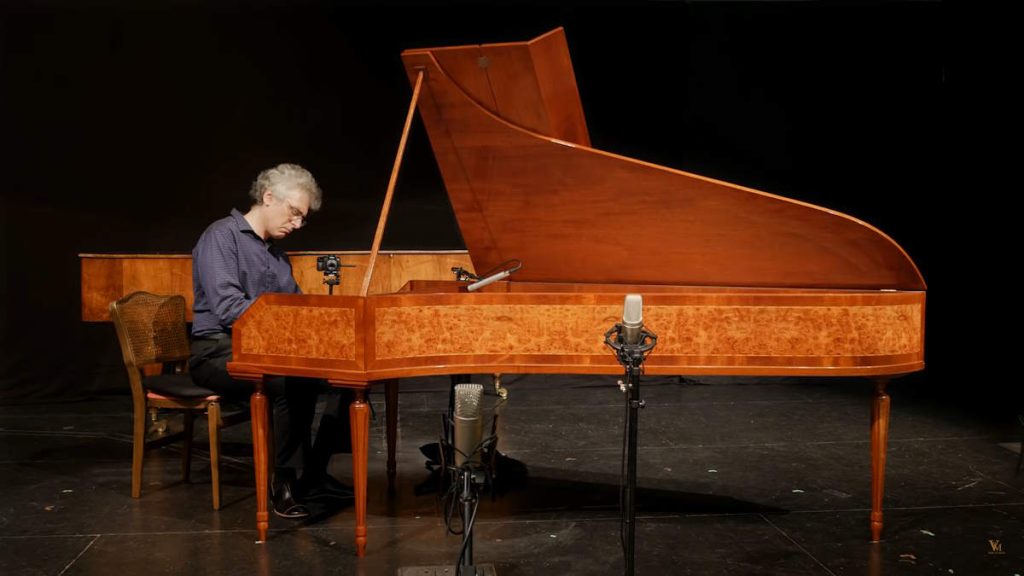Ukrainian classical pianist Anna Fedorova performs Ludwig van Beethoven’s Piano Sonata No. 14 in C-sharp minor, marked Quasi una fantasia, Op. 27, No. 2, commonly known as the “Moonlight Sonata”, and Frédéric Chopin’s Ballade No. 4 in F minor, Op. 52. This performance was recorded in TivoliVredenburg Utrecht for VPRO Vrije Geluiden: a music program made by the Dutch public broadcast organization VPRO.
Ludwig van Beethoven’s Piano Sonata No. 14, the “Moonlight Sonata”
The “Moonlight Sonata,” officially titled “Piano Sonata No. 14 in C-sharp Minor, Op. 27, No. 2,” is one of Ludwig van Beethoven’s most famous compositions. Composed in 1801 and dedicated to his pupil, Countess Giulietta Guicciardi, the piece marks a significant development in the piano sonata form and showcases Beethoven’s expanding musical expression. The nickname “Moonlight Sonata” comes not from Beethoven himself, but from a description by the German music critic Ludwig Rellstab, who in 1832 likened the effect of the first movement to that of moonlight shining upon Lake Lucerne in Switzerland. This poetic title has since become synonymous with the sonata itself.
The sonata is renowned for its profound emotional depth and structural innovation. Beethoven’s approach to the form and harmony of the sonata broke away from the classical mold of his predecessors, like Haydn and Mozart, by introducing a more intimate, almost conversational style of music. This was a novel use of the sonata form at the time, pushing the boundaries of musical narrative and emotional expression in instrumental music.
This piece also reflects Beethoven’s transition from the Classical style to his own more personal, emotional, and dramatic form of composition, which would later define much of the Romantic era in music. It is celebrated not only for its technical difficulty but also for its ability to evoke a wide range of emotions throughout its duration. The sonata remains a staple in the repertoire of pianists and a beloved piece among classical music enthusiasts, often being seen as a profound exploration of the human psyche through music.
Movements
1. Adagio sostenuto
The first movement of Beethoven’s “Moonlight Sonata” is arguably the most famous and has left a profound impact on listeners and performers alike. Marked as “Adagio sostenuto,” it is characterized by its slow pace and the deep, contemplative mood it evokes. The movement is structured around a simple but haunting triplet figuration in the right hand, set against a steady crotchet pulse in the left, creating an almost hypnotic rhythmic consistency throughout the piece. This repetitive pattern, combined with a melody that flows above it, gives the movement a somber and ethereal quality.
What sets this movement apart is its use of form and tonality. It is played almost entirely using the damper pedal, which was a novel effect at the time, creating a unique, flowing sound that resembles the sustained harmonies of a string ensemble. This continuous use of the pedal, along with the uninterrupted rhythm, helps to sustain a dream-like, otherworldly feeling, aligning well with the moonlight imagery associated with the sonata.
Furthermore, the movement is in C-sharp minor, a key that Beethoven chose for its deep expressiveness and potential for dramatic contrast, which he would exploit more fully in the following movements. The opening movement does not adhere strictly to the traditional sonata form, which usually features contrasting themes and a development section. Instead, Beethoven focuses on creating an atmosphere and mood, relying on the tension between melody and accompaniment to drive the emotional narrative of the music.
This approach was revolutionary and showed Beethoven’s willingness to subvert classical forms to achieve a greater emotional impact. This movement, with its serene yet melancholic ambiance, has become emblematic of Beethoven’s capacity to convey profound sentiments through innovative musical structures. It remains one of the most admired and interpreted compositions in classical piano repertoire, embodying the transition from the Classical to the Romantic era in music.
2. Allegretto
The second movement of Beethoven’s “Moonlight Sonata” serves as a stark contrast to the first. It is marked “Allegretto,” which indicates a moderately fast pace and is structured in the form of a scherzo and trio, a common format in Beethoven’s sonatas. This movement provides a light, almost playful interlude between the deeply introspective first movement and the turbulent final movement.
In terms of musical content, the second movement is much shorter and simpler than the others. It features a graceful and straightforward melody in D-flat major, which gives it a warm and more uplifting character compared to the somber minor key of the first movement. The key choice here is crucial; D-flat major often sounds less tense and more lyrical than C-sharp minor, lending a sort of relief and pause to the overall mood of the sonata.
The scherzo part of the movement is rhythmic and dance-like, with a cheerful disposition that seems almost to cleanse the palate after the emotional depth of the Adagio sostenuto. Following the scherzo, the trio section introduces a change in texture and mood that is more reflective yet still retains the light-hearted character. This middle section is essential as it provides a contrast within the movement itself, before returning to the initial theme.
3. Presto agitato
The third movement of Beethoven’s “Moonlight Sonata” is a dramatic and vigorous conclusion to the sonata. It is marked “Presto agitato,” indicating a very fast pace and agitated mood. This movement is in sonata form, which includes an exposition, development, and recapitulation, and it returns to the somber and turbulent key of C-sharp minor, bringing the composition full circle.
The movement opens with a stormy, relentless melody that immediately establishes a sense of urgency and intensity. The right hand plays rapid, arpeggiated figures and scales that demand technical prowess, while the left hand provides strong, driving rhythms that enhance the overall turbulence of the piece. The music here is emotionally charged and reflects a struggle or conflict, with dynamic contrasts and dramatic shifts that keep the listener engaged.
During the development section, Beethoven explores different keys and introduces new material that heightens the dramatic tension of the movement. This section is characterized by its complexity and the intricate interplay between the hands, showcasing Beethoven’s innovative use of harmony and rhythm to convey deep emotional narratives.
As the movement progresses toward the recapitulation, the original theme is reintroduced and brings with it a return to the initial emotional state, now even more intensified. The recapitulation serves to resolve the tensions built up during the development, but it does so with a heightened sense of drama and urgency.
The movement concludes with a coda that pushes the emotional and technical boundaries even further. This final section accelerates and intensifies, leading to a powerful and emphatic conclusion. Beethoven’s use of a fast tempo, combined with the relentless energy and complex interplay of melodies, ensures that the sonata ends with a profound impact.
Frédéric Chopin’s Ballade No. 4
Frédéric Chopin’s Ballade No. 4 in F minor, Op. 52, composed in 1842, is considered one of his most complex and profoundly expressive works for solo piano. It is the last of his four ballades, a form that he both pioneered and perfected, which blends narrative drama and lyrical expression in a free musical form, akin to the poetic ballad in literature.
The Ballade No. 4 starts with a quiet and reflective introduction that quickly gives way to a theme of haunting beauty. This theme, played first in a simple and unadorned manner, sets the stage for a piece that is rich in both technical challenges and emotional depth. As the ballade progresses, the theme undergoes a series of transformations – each version more intricate and intense than the last, weaving through different moods and keys, building a narrative that is both compelling and elusive.
The structure of the ballade is not straightforward and is subject to much analysis and interpretation. It doesn’t follow a strict form, such as sonata form, but rather evolves through a series of thematic developments and key changes, which maintain a sense of forward motion and narrative development. The piece has been described as cyclical in nature, with the main themes returning with new variations and in different contexts, contributing to a sense of overarching cohesion and narrative depth.
Technically, the piece is demanding. It requires a pianist who can not only manage the technical challenges of the rapid passages, leaps, and intricate fingerwork but also express the wide range of emotions contained within the piece. From delicate passages to thunderous climaxes, Chopin’s emotional landscape in this ballade is vast, requiring both sensitivity and virtuosic skill.
The climax of the ballade is a breathtaking section marked “Presto con fuoco,” which translates to “very fast with fire.” This part of the piece is intensely passionate and technically formidable, pushing the boundaries of the pianist’s capabilities. It leads to a dramatic and powerful conclusion, resolving the accumulated tensions of the earlier sections in a satisfying and emotionally charged finale.
Chopin’s Ballade No. 4 is widely regarded as a masterpiece of the romantic piano repertoire, embodying the height of Chopin’s powers in creating music that is as technically challenging as it is emotionally deep. It remains a favorite among pianists and a profound experience for audiences, capturing a rich emotional narrative that is both personal and universal.
Sources
- Piano Sonata No. 14 (Beethoven) on Wikipedia
- Piano Sonata No. 14, Op. 27 No. 2 (Beethoven, Ludwig van) on the International Music Score Library Project website
- Ballade No. 4 (Chopin) on Wikipedia
- Ballade No. 4, Op. 52 (Chopin, Frédéric) on the International Music Score Library Project website




